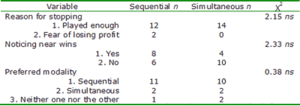The WAGER Vol. 7(46) – It’s All in the Presentation: Symbol Sequence and Gambling Behavior
Conventional wisdom has it that casinos are architecturally and technologically designed to maximize customers’ gambling time. Architecture aside, some research suggests that casino games can be modified to increase the length of gambling sessions (e.g. Griffiths, 1991; Griffiths, 1993; Reid, 1986; Strickland & Grote, 1967). This week the WAGER reviews a recent study by Ladouceur and Sévigny (2002) which compares the gambling behaviors of players who used video lottery terminals (VLTs) programmed to present the symbols in the usual, sequential way, one after another, with a slight delay between each versus those who used machines programmed for a simultaneous presentation of all the pictures at once.
Ladouceur and Sévigny selected 28 (14 men) study participants through Quebec City newspaper advertisements and bulletin board postings at Laval University. Respondents identified as probable pathological gamblers by a French version of the South Oaks Gambling Screen (SOGS) were excluded from participation. Each subject was given $10 for gambling; subjects were told that they could win up to $15 more by accumulating credits while playing the “Swinging Bells” VLT game.1 To ensure that potential loss would not affect gambling behavior, subjects were assured that they would leave with at least $10 for participating in the study. Participants were randomly assigned to play machines programmed to display either simultaneous symbols or sequential symbols. Each gambling session ended when the participant either decided to stop or lost the $10 in machine credits. The authors measured player gambling factors such as persistence (i.e., the number of games played by each subject), reasons for stopping, noticing near wins, and preferred modalities.
Using player experience as a covariate, the authors employed an analysis of covariance (ANCOVA) to demonstrate that participants in the sequential group played an average of 130 more games than participants in the simultaneous group [F(1,25) = 7.133, p<.01]. No significant between group difference was found for participants’ reported reason for stopping, noticing near wins, or preferred modality (Table 1). However a post-hoc analysis indicated that regardless of experimental group, significantly more people preferred the sequential format (21 of 28) [ .2(1, N=28) = 21.93, p<.001].
Table 1. Frequency of Participants Per Group and Chi-Square Statistics for Questionnaire Variables (Ladouceur & Sévigny, 2002)
The authors used an experimental design that allows for random assignment of subjects into conditional
groups. However, the study had several design limitations. For example, the relatively small sample size might have produced results that are uncharacteristic of the gambling population as a whole. Small sample size could also make the use of the covariate for gambling experience less effective; perhaps better would have been to match subjects based on experience before assigning them to experimental groups. Further, the study design lacks the potential for personal loss; this circumstance could have influenced the results pertaining to duration of participant gambling sessions. Finally, the study’s sole focus on non-pathological subjects leaves the impact of sequence and simultaneous gambling experiences on pathological gamblers unknown. The findings obtained with healthy gamblers might be amplified, minimized or irrelevant to pathological gamblers’ playing decisions.
Despite these concerns, this research is important because it draws attention to subtle factors that can shape gambling behavior. While symbol sequence is certainly not the only factor that influences gambling behavior, its importance and role as a contributing component of overall gambling patterns deserves more attention. The role of symbol sequence likely will be important as the gaming industry continues to develop more sophisticated and effective responsible gaming programs and mechanisms, such as slot machines and VLTs with integrated responsible gaming features (e.g., on-screen clocks, cash betting, and mandatory cash out). Next week’s WAGER will explore the pros and cons of such features, and examine the results of the first public trial of slot machines with protective devices.
Comments on this article can be addressed to Tony Donato.
Notes
1. The “Swinging Bells” VLT machine displays nine symbols arranged in a 3×3 matrix.
References
Griffiths, M. D. (1991). The psychology of the near miss in fruit machine gambling. Journal of Psychology, 125, 347-357.
Griffiths, M. D. (1993). A study of the cognitive activity of fruit machine players. In J. A. Cornelius (Ed.), Gambling behavior and problem gambling (pp. 85110). Reno: Institute for the study of gambling and commercial gaming.
Ladouceur, R., & Sévigny, S. (2002). Symbols presentation modality as a determinant of gambling behavior. Journal of Psychology, 136(4), 443-448.
Reid, R. L. (1986). The psychology of the near miss. Journal of Gambling Behavior, 2(1), 32-39.
Strickland, L. H., & Grote, F. W. (1967). Temporal presentation of winning symbols and slot-machine playing. Journal of Experimental Psychology, 74(1), 10-13.
